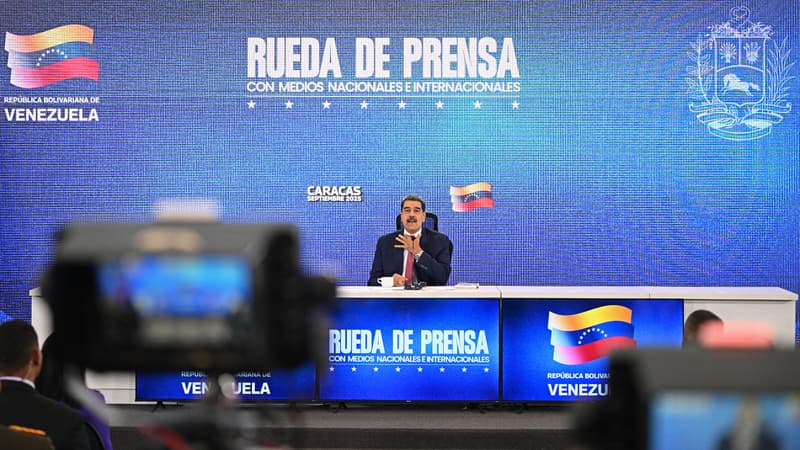The propaganda never stops. And with good reason: it doesn’t need to eat, sleep or even breathe… especially when it’s powered by “robots.” Two avatars generated by artificial intelligence, Noah and Daren, presented as journalists from the fictitious channel House of News, broadcast reports that praise the good economic health of Venezuela through flattering figures on tourism and sports, despite the fact that the country is in crisis.
This story, highlighted by the Spanish-speaking newspaper El País, reveals the use of avatars generated by artificial intelligence. They take the form of fake television news presenters and are mainly used to spread pro-government messages and videos.
Created with Synthesia software, these fake presenters are part of a series of reusable avatars (doctor, worker, chef, etc.), already used in pro-Chinese disinformation campaigns. Their videos, widely disseminated on YouTube, Tiktok and even broadcast on Venezuelan public television, thus participate in the propaganda of the government of Nicolás Maduro (president of Venezuela, ed.).
Futuristic robots and fake images.
In a context of high tensions between Caracas and Washington, relations have deteriorated even further after the deployment, almost a month ago, of US warships and a submarine in the Caribbean, officially to fight drug trafficking to the United States. According to the Pentagon, at least three boats belonging to suspected traffickers from Venezuela have since sunk, resulting in the deaths of fourteen people.
Behind these two AI presenters, endless images generated by artificial intelligence. In a Tiktok account that brings together several tens of thousands of subscribers, several videos of futuristic combat robots appear, supposedly affiliated with Venezuela and presented as “the new generation of guardians” of the country. These robots, taken directly from movies like Terminator or Avatar… evidently do not exist.
But more serious videos and photographs are circulating. Among them, some, close to accounts linked to Venezuelan power, proudly show the “military power” of the South American country. There you can see modernized Soviet-made T-72 tanks, Chinese VN-1 armored vehicles and even Russian Sukhoi Su-30 multirole fighters. The stated objective: to demonstrate that Venezuela is ready.
Intense digital propaganda
“Right now, there is intense propaganda from Maduro and his most loyal followers, on television and on social networks. It is part of a long political history. Since the Chávez era, the United States has been presented as the main enemy. And sometimes rightly so, since it supported the coup attempt against Chávez in 2002 and imposed sanctions that have contributed to the economic crisis since 2014,” explains Thomas Posado. professor of Latin American civilization at the University of Rouen and author of Venezuela: from revolution to collapse. Trade unionism as a prism of the political crisis (PU del Midi, 2023).
The Venezuelan government has long used television and classic propaganda, but now also social networks. “We have seen many images of military power created by artificial intelligence circulate, and even cartoons like ‘Super Bigote’, a superhero with the image of Maduro. The objective is to reach a broader audience, including young people who do not necessarily watch the televised speeches. Along with this fanciful propaganda, there are also real military demonstrations that add to this story of strength and resistance,” develops Thomas Posado.
Although this speech retains a certain resonance, “today it only convinces a very minority core of the population,” says Thomas Posado. “What dominates the daily lives of Venezuelans is the crisis. But Donald Trump’s repeated threats allow the regime to reactivate this anti-imperialist rhetoric,” he adds.
Adrián González, founder of Cazadores de Fake News, a website that debunks Venezuelan disinformation, tells the BBC that the government uses propaganda “to neutralize information that it does not control” in order to influence public perception online. For her part, Marivi Vázquez, from ProBox, an NGO that fights against online disinformation in Latin America, also adds to British radio that the use of this abundant digital propaganda aims to alter the “trends” algorithm by contaminating it with pro-government messages.
The United States is also at stake
But the “digital campaign” is also active on the American side. In numerous videos broadcast on Tiktok or on the X platform, they make fun of the Venezuelan army. We see elderly people, pregnant women and even children “disguised” as soldiers or militiamen, accompanied by comments such as: “This is what the Venezuelan army is capable of in 2025” or “They will never measure up.”
This content, distributed primarily by accounts close to Donald Trump and the MAGA movement, illustrates another facet of the digital war. Supporters of the intervention, although a minority in the American political class, chose to fight their battle first on the Internet and social networks.
And part of the opposition to Nicolás Maduro is aligning itself with Donald Trump’s speech, hoping that foreign intervention could precipitate the fall of the regime. “The opposition remains active, but fragmented. There are hundreds, even thousands of demonstrations each year, tolerated as long as they are not coordinated. The most radical sectors, led by María Corina Machado, have the greatest capacity for mobilization. Since the 2024 elections, they have very little freedom to organize demonstrations. The Internet, and in particular social networks, continue to be one of the only spaces for freedom,” Thomas Posado tells us.
In a country where many news sites are now inaccessible, VPN use is experiencing considerable growth, making Venezuela one of the territories where these circumvention tools are among the most used in the world. This phenomenon is also part of a pattern similar to that observed in other countries, such as Nepal or Indonesia, where young people, very active online, use memes in particular as a means of expression and mobilization.
Source: BFM TV


